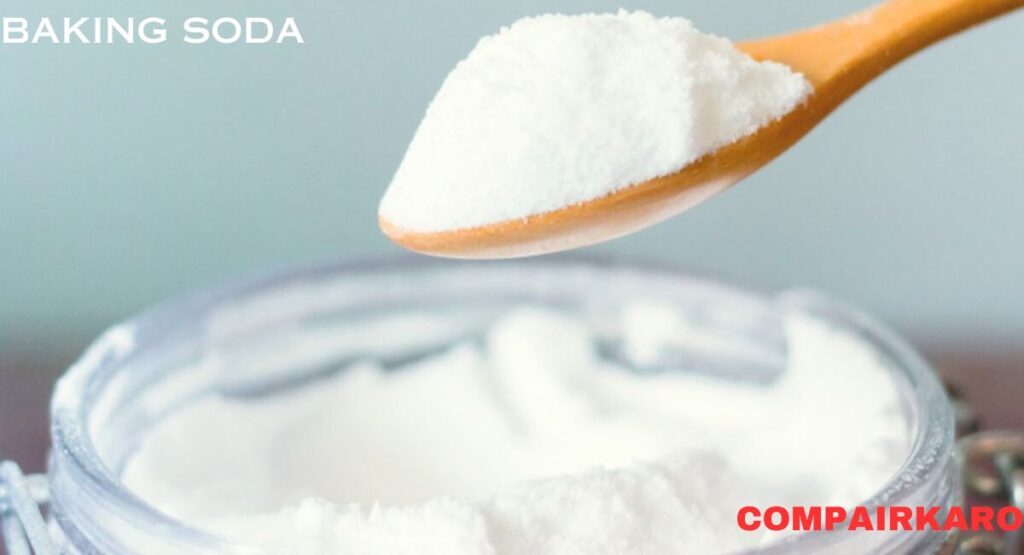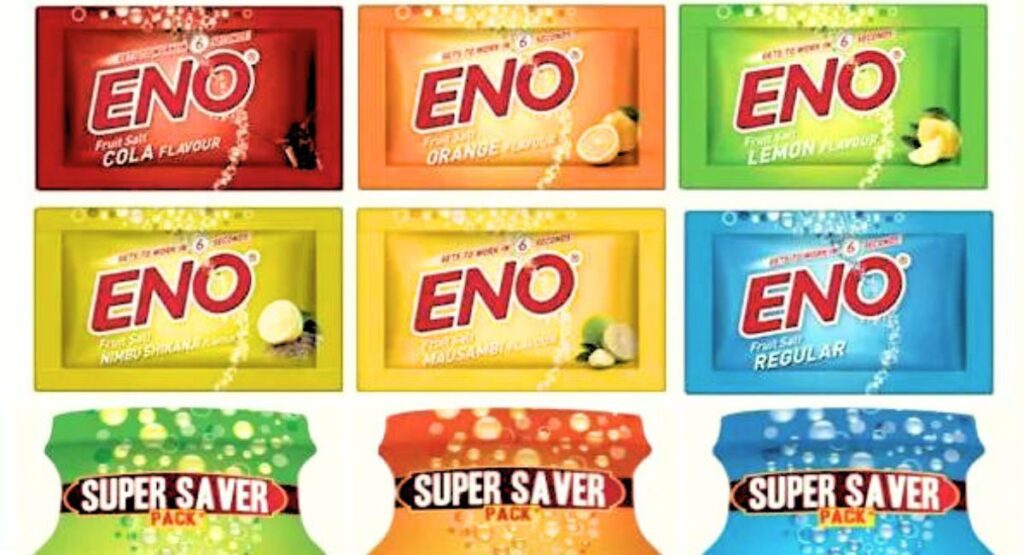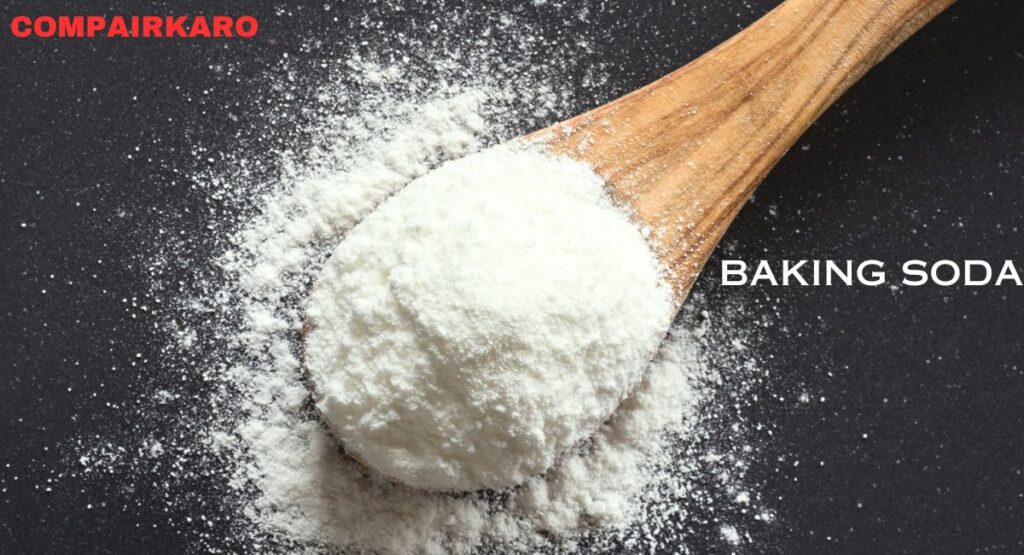In the world of culinary and household applications, two versatile substances have found a place in every kitchen – eno and baking soda. Both ENO and baking soda play an important role as leavening agents, providing the desired rise and fluffiness to baked goods. However, their usefulness extends far beyond the oven, as they serve a number of purposes, from alleviating digestive discomfort to acting as efficient cleaning agents.
In this comprehensive comparison, we’ll look at the fascinating properties of eno and baking soda, investigate their chemical structures, explore their diverse uses, and discover how they bring a touch of magic to our everyday lives. Whether you’re an experienced chef, health-conscious individual, or home enthusiast seeking an effective solution, join us on this enlightening journey to uncover the unique powers of ENO and baking soda, and find out which one is yours. Could be the ultimate kitchen companion.
1. Composition and Ingredients
ENO
Eno, a popular antacid and effervescent fruit salt, primarily contains sodium bicarbonate (baking soda) and citric acid as its main ingredients. Additionally, it may contain small amounts of sodium carbonate, which helps to increase its intensity when dissolved in water. Some types of eno may also contain flavoring agents and sweeteners to make it more palatable when consumed as a digestive aid.

Baking Soda
Baking soda, scientifically known as sodium bicarbonate, has only one major ingredient: sodium bicarbonate. This white crystalline powder is a leavening agent widely used in baking to help dough rise and create a light, airy texture in various baked goods. Unlike eno, baking soda doesn’t contain any citric acid or flavorings, as it focuses primarily on its leavening properties.

Key Differences
The main difference between eno and baking soda lies in their added components and primary purposes.
1. Function
- Eno: Apart from acting as a leavening agent, Eno is commonly used as an antacid to relieve heartburn, indigestion and acidity due to the presence of citric acid.
- Baking soda: Its main role is as a leavening agent in baking, which helps doughs and batters rise by releasing carbon dioxide when combined with acidic ingredients.
2. Ingredients
- ENO: Contains both sodium bicarbonate and citric acid, which contribute to its dual purpose as a digestive aid and leavening agent.
- Baking Soda: Contains only sodium bicarbonate, focusing specifically on its leavening ability.
3. Taste and Flavor
- Eno: Often available in flavored versions, eno has a tart flavor due to the presence of citric acid.
- Baking soda: It’s tasteless and doesn’t add any flavor to recipes, making it ideal for neutral-tasting recipes.

4. Applications
- ENO: Widely used as an antacid for digestive relief and as a quick remedy for acidity and heartburn. Its anti-inflammatory properties make it a popular choice for quick relief.
- Baking Soda: Mainly used in baking to create a light, fluffy texture to cakes, muffins, and breads. It is also used for some cleaning and deodorizing tasks around the home.
While both ENO and baking soda contain sodium bicarbonate, their added components and intended uses differentiate them. Eno’s inclusion of citric acid makes it an easy digestive aid, while baking soda’s special focus on leavening makes it indispensable for bakers and cooks. Understanding these differences helps in using them effectively and harnessing their unique properties in various applications.
2. Culinary Uses
ENO
- Leavening Agent: ENO acts as a quick and effective leavening agent in some culinary applications. When it is mixed with acidic ingredients like curd or buttermilk, it releases carbon dioxide, which causes batter and dough to rise and creates an airy texture in dishes like dhokla, idli and other steamed or fermented foods.
- Acidity regulation: Eno is renowned for its antacid properties, and in the culinary world, it can even help control acidity levels in some dishes. It can be used to neutralize excess acidity in recipes, especially recipes that include acidic fruits or ingredients, allowing for a well-balanced flavor profile.
- Flavor enhancement: Some types of eno come in flavored versions, such as lemon or orange, which can impart a subtle tart flavor to dishes. This flavor enhancer can be used creatively in beverages, desserts and even savory dishes, adding a refreshing twist to the overall taste.
Baking Soda
- Leavening Agent: Baking soda is a major leavening agent used extensively in baking. When it is mixed with acidic ingredients such as buttermilk, vinegar or lemon juice, it produces carbon dioxide, which causes the dough or batter to rise, resulting in a light, fluffy texture in baked goods such as cakes, muffins, and pancakes. texture is created.
- pH regulation: In addition to its leavening role, baking soda acts as a pH regulator, especially in recipes with acidic ingredients. It neutralizes acidity and helps maintain a balanced pH level, which is essential for achieving the desired texture and flavor in various culinary creations.

- Flavor enhancer: While baking soda itself is tasteless, it indirectly enhances flavor by reducing acidity in some dishes. By neutralizing acidity, baking soda allows the natural flavors of ingredients to shine through without being overwhelmed by sourness.
Key Differences
The culinary applications of ENO and baking soda overlap in some areas as a leavening agent and pH regulator. However, eno’s unique role as an antacid sets it apart, making it an effective solution for digestive relief and acidity regulation in specific recipes. Baking soda, on the other hand, is excellent as a pure leavening agent, contributing to the lightness and texture of baked goods, while also controlling the pH level in acidic mixtures. Both of these culinary powers bring their strengths to the kitchen, providing a wide range of possibilities for creating delightful and well-balanced dishes.
3. Health and Medicinal Uses
ENO
- Digestive Aid: ENO is widely known for its digestive benefits. When taken with water, it helps relieve indigestion, bloating and gas by expelling trapped gases in the digestive tract. Its non-flammable nature provides quick relief from discomfort.
- Antacid Properties: The primary medicinal use of eno is as an antacid. Its combination of sodium bicarbonate and citric acid helps neutralize excess stomach acid, thereby providing relief from heartburn, acidity and acid reflux.

- Remedy for acidity: Due to its antacid properties, ENO acts as a fast-acting remedy for acidity. It helps in balancing the pH level in the stomach, thereby reducing the burning sensation caused by excess acid in the stomach.
Baking Soda
- Digestive Aid: Baking soda, when consumed in moderation and under proper guidance, can help reduce indigestion and bloating. It works in a similar way to eno and draws out gas trapped in the digestive tract, thereby relieving discomfort.
- Antacid Properties: The main ingredient of baking soda, sodium bicarbonate, acts as a powerful antacid. When consumed, it neutralizes stomach acid, making it an effective remedy for heartburn and acid reflux.
- Remedy for acidity: As a quick-acting antacid, baking soda is often used to combat acidity and soothe an upset stomach. However, it should be used with caution and in moderation, as excessive consumption can lead to health issues.
Key difference:
Both ENO and baking soda offer similar health benefits and medicinal uses related to digestion, antacid properties, and treatment of acidity. However, Eno’s formulation includes citric acid, which contributes to its effervescence and enhances its digestive and antacid effectiveness. Baking soda, on the other hand, contains only sodium bicarbonate, making it a pure and potent antacid, but without the effervescence typically associated with ENO.
Cautionary Note:
While both eno and baking soda can provide relief from digestive problems and acidity, it is important to use them in moderation and as directed. Excessive consumption of baking soda in particular can lead to an imbalance in the pH level of the body and have adverse health effects. For chronic digestive problems or persistent acidity problems, it is always best to consult a healthcare professional for proper diagnosis and personalized treatment.
4. Side Effects and Precautions
ENO
- Excess sodium intake: ENO contains sodium bicarbonate and consuming it in excess can lead to increased sodium levels in the body. This may be of concern to people with high blood pressure or those on a low-sodium diet.
- Alkalosis: Prolonged and excessive use of eno can result in a condition called alkalosis, where the body’s pH level becomes too alkaline. Alkalosis can cause symptoms such as muscle twitches, hand tremors, and nausea.
- Gas and belching: Although eno is effective in relieving gas and bloating, overuse can cause excessive gas and belching, which can cause discomfort.
Precaution:
Eno should be used exactly as directed and in the recommended dosage. Avoid excessive or repeated use unless prescribed by a healthcare professional.
Individuals with kidney problems, high blood pressure or edema should consult a doctor before using eno due to its sodium content.
Pregnant or lactating women and people with a history of kidney stones should exercise caution when using eno and seek medical advice if necessary.
Baking Soda
- Sodium overload: Baking soda is primarily composed of sodium bicarbonate, and excessive consumption of it can lead to increased sodium levels in the body. This is of concern for individuals with sodium-sensitive conditions.
- Alkalosis: Similar to ENO, using baking soda in excess can disrupt the pH balance of the body, leading to alkalosis and its associated symptoms.
- Gastrointestinal Distress: An overdose of baking soda can cause stomach upset, nausea, and vomiting.

Precaution:
Baking soda should be used in moderation and only as a short-term treatment for digestive problems. Prolonged or excessive use is not recommended.
Individuals with high blood pressure, kidney problems and those on sodium-restricted diets should avoid using baking soda without consulting a health care professional.
Avoid using baking soda as a long-term solution to chronic digestive problems without medical supervision.
Conclusion:
Both eno and baking soda can provide relief from some digestive problems and acidity when used judiciously. However, it is important to exercise caution and follow recommended dosages to prevent possible side effects and complications associated with excessive intake. If individuals experience persistent or severe digestive problems, it is essential to consult a health care professional for proper diagnosis and treatment.
People also Reads :- Kitkat Vs Dairy Milk
5. Fizzing and Effervescence
The Science Behind Fizzing and Effervescence in ENO and Baking Soda
ENO
The fizzing and effervescence seen in eno is the result of a chemical reaction between its two main components: sodium bicarbonate (baking soda) and citric acid. When eno is mixed with water, these two compounds come into contact, starting a reaction. The reaction can be represented as:
sodium bicarbonate + citric acid + water → sodium citrate + carbon dioxide + water
The citric acid in ENO acts as the acidic component, and the sodium bicarbonate provides the base. When these substances react with water, they undergo chemical decomposition, producing carbon dioxide gas as a byproduct. The released carbon dioxide forms bubbles, causing characteristic foaming and effervescence.
Contribute to various applications:
- Digestive relief: The effervescence present in eno helps in providing quick relief from digestive discomfort. Upon consumption, bubbles of carbon dioxide expand in the stomach, thereby expelling trapped gas and relieving bloating and indigestion.
- Antacid Properties: The carbon dioxide produced during the reaction with stomach acid helps in neutralizing the excess acidity, reducing the symptoms of heartburn and acidity.
- Taste Enhancement: The fizzy feel and tart flavor in flavored eno variants add a refreshing twist to beverages and some culinary creations, enhancing their overall taste.
Baking Soda
The bubbling in baking soda is also the result of a chemical reaction, but here, the reaction occurs when the baking soda encounters the acidic ingredients in the dishes. When baking soda is mixed with an acid such as buttermilk, vinegar, lemon juice or yogurt, the following reaction occurs:
sodium bicarbonate + acid → sodium salt + carbon dioxide + water
Similar to the reaction in ENO, this process generates carbon dioxide gas, forming bubbles and resulting in the characteristic fizzing and bubbling.

Contribute to various applications:
Leavening agent: In baking, the release of carbon dioxide during the reaction causes the dough or batter to rise. The gas expands in the heat of the oven, creating air pockets, which give baked goods a light and puffy texture.
Acidity regulation: Baking soda’s ability to neutralize acidity is valuable in recipes where an acidic ingredient is used. This helps to balance pH levels, prevent excessive sourness in some dishes, and achieve a more balanced flavor.
Conclusion:
The fizzing and bubbling in both ENO and baking soda is the result of chemical reactions between their respective ingredients and the acidic components. These reactions play an important role in a variety of applications, ranging from providing digestive relief and antacid properties in ENO to acting as a leavening agent and pH regulator in baking soda. Understanding the science behind these reactions helps us appreciate the versatility and usefulness of these ingredients in a variety of culinary and medicinal contexts.
6. Household Cleaning and Deodorizing
ENO
ENO, known primarily for its culinary and medicinal uses, is not as commonly used for household cleaning as baking soda. Although it has some cleaning properties due to its alkaline nature, it is not as effective as baking soda in many cleaning scenarios.
Typical use cases of eno as a cleaning agent and deodorizer:
- Toilet Bowl Cleaner: The intensity and mild alkalinity of eno can help freshen a toilet bowl by reducing stains and neutralizing odors. Simply pour some Eno in the toilet bowl, let it settle, and then scrub with a toilet brush.
Baking Soda
Baking soda is a well-known and highly effective household cleaning agent and deodorizer. Its natural abrasive and odor-absorbing properties make it a versatile choice for a variety of cleaning jobs.
Typical use cases of baking soda as a cleaning agent and deodorizer:
- Surface Cleaner: Baking soda can be used as a gentle abrasive cleaner for surfaces such as countertops, sinks and stovetops. It effectively removes dirt, stains and odors without scratching surfaces.
- Refrigerator deodorizer: Keeping an open box of baking soda in the refrigerator helps absorb food odors, keeping the fridge smelling fresh.
- Carpet and upholstery deodorizer: Sprinkling baking soda on carpet or upholstery before vacuuming can help eliminate odors, leaving the space cleaner.
- Garbage Disposal Cleaner: Adding baking soda to the garbage disposal along with water helps to deodorize and clean the unit.
- Silverware Cleaner: Making a paste of baking soda with water can help polish silverware and other metal items and restore their shine.
- Laundry Booster: Adding baking soda to laundry helps neutralize odors and increases the effectiveness of laundry detergent.
Conclusion:
While eno has limited application as a household cleaning agent and deodorizer, baking soda shines as a versatile and effective option for a variety of cleaning tasks. Its natural cleaning and deodorizing properties make it the perfect solution for tackling household chores while keeping living spaces fresh and clean.
7. Environmental Impact
ENO
ENO, which is used primarily as a culinary and medicinal product, has limited direct environmental impact. However, like any manufactured product, its production and packaging contribute to its overall environmental footprint.
Biodegradability and eco-friendliness of eno:
Biodegradability: ENO contains sodium bicarbonate and citric acid, both of which are biodegradable compounds. When disposed of properly, eno can naturally break down over time, reducing its impact on the environment.
Packaging: The environmental impact of ENO is affected by its packaging. Manufacturers and consumers can make more eco-friendly choices by choosing recyclable or biodegradable packaging materials.
Baking Soda
Baking soda, also known as sodium bicarbonate, has a more significant impact on the environment due to its widespread use in a variety of applications, including cleaning and deodorizing.
Biodegradability and Eco-friendliness of Baking Soda:
Biodegradability: Baking soda is a naturally occurring compound that is easily biodegradable. It can break down into its harmless components without leaving harmful residues, making it a safer option for the environment.
Cleaning agent: The eco-friendliness of baking soda shines when used as a household cleaning agent. Its non-toxic nature makes it a safer alternative to many chemical-laden cleaners that can adversely affect aquatic life and soil health if disposed of improperly.
Deodorizer: Baking soda’s ability to absorb odors without releasing harmful chemicals into the air makes it a great choice for deodorizing spaces, reducing the need for aerosol-based air fresheners that contribute to air pollution. Are.
Environment-Friendly Practices:
To further enhance the environmental friendliness of both eno and baking soda, consumers can adopt the following practices:
Proper Disposal: Properly dispose of both eno and baking soda by following local waste disposal guidelines. Recycling packaging materials whenever possible helps reduce waste.
Bulk Buying: Opt for bulk buying to cut down on excess packaging and reduce overall waste generation.
Natural cleaning solutions: Include baking soda in natural cleaning solutions to avoid harsh chemicals that harm the environment and waterways.
Eco-conscious brands: Choose products from brands that prioritize eco-friendly manufacturing processes and packaging materials.
Conclusion:
Both eno and baking soda exhibit relatively positive environmental characteristics. While the direct impact of eNO is limited, baking soda stands out as a naturally biodegradable and eco-friendly alternative. The eco-friendliness of both these versatile substances can be further enhanced by incorporating responsible disposal practices and making conscious choices, which can contribute to a cleaner and greener environment.
8. Culinary Tips and Tricks
ENO
- Leavening agent for fluffy batter: While making dishes like dhokla or idli, add eno to the batter just before steaming. This will ensure quick and uniform growth, resulting in a light and fluffy texture.
- Acidity regulation in curries: To balance the acidity in tomato-based curries or gravies, add a pinch of eno. This will help neutralize the excess acidity without compromising the overall flavor.
- Refreshing Beverages: Create fizzy and refreshing homemade drinks by adding ENO to citrus juices or mocktails. The zest will add a delightful twist to your beverages.
Baking Soda
Leavening power for baked goods: For recipes that require a leavening agent, make sure you use enough acidic ingredients such as buttermilk, yogurt, or vinegar to properly activate the baking soda. Are. This will result in well-risen and puffed baked goods.
- Deodorize the fridge: Keep an open container of baking soda in your refrigerator to effectively absorb food odors. Change it every few months to maintain freshness.
- Homemade Cleaning Paste: Make a natural cleaning paste by mixing baking soda with a small amount of water. Use this paste to scrub and clean surfaces like sinks, stovetops, and countertops.
Tips for both ENO and baking soda:
- Avoid overuse: Both ENO and baking soda should be used in moderation. Using them in excess can result in unwanted flavors or textures in your dishes.
- Immediate use: Once activated, the leavening effect of eno and baking soda is time sensitive. Hence, it is necessary to bake or cook the batter immediately after adding these ingredients.
- Mix with dry ingredients: When using baking soda as a leavening agent, mix it with dry ingredients before adding wet ingredients. This ensures uniform distribution in the batter.
- Store properly: Keep ENO and baking soda containers tightly sealed and in a cool, dry place to maintain their effectiveness.
- Test the freshness: To test whether baking soda is still active, mix a small amount with vinegar or lemon juice. If it fizzes loudly, it’s still fresh and potent.
- Experiment with ratios: Experiment with the ratio of eno and baking soda in your recipes to find the right balance for your flavor preferences.
Conclusion:
ENO and baking soda are both versatile kitchen companions, enhancing culinary creations in their own unique ways. By following these practical tips and tricks, you can effectively use eno and baking soda in cooking, baking and even household applications, ensuring pleasant results and creating a tidy and fresh living space Can keep
9. Cost and Accessibility
Comparison of Cost and Availability of ENO and Baking Soda in Different Regions
COST
- The price of eno and baking soda may vary depending on the region and availability of raw materials. Generally, baking soda is more affordable than ENO, making it a cost-effective option for a variety of culinary and household applications. Baking soda is mass-produced and is widely available, which contributes to its low price.
- On the other hand, ENO, being a branded product with added flavor and medicinal properties, can be relatively more expensive than baking soda. The cost of eno can vary depending on packaging, quantity and any added features such as different flavors.
Availability
- Baking soda has wide availability and can be found in most grocery stores, supermarkets and convenience stores around the world. It is a staple ingredient in baking and is often used in various cleaning and deodorizing functions, contributing to its ubiquitous presence.
- Eno being a specialty product with dual roles as a culinary leavening agent and antacid, its availability may vary in different regions. In some areas, eno can be commonly found in grocery stores and pharmacies due to its medicinal use. However, in areas where it is not commonly used, finding eno may require going to specialty stores or pharmacies.
Informed choice
- For budget conscious consumers or those looking for a versatile and affordable option, baking soda is a highly recommended option. Its wide availability and cost-effectiveness make it a valuable addition to any kitchen and home.
- For specific culinary or medicinal needs, eno may be a suitable option, especially when seeking a convenient solution to acidity or digestive problems. However, given its potentially high cost and varying availability, consumers should ensure they can find eno in their local area before relying on it as a primary fermentation or medicinal agent.
- Ultimately, when making an informed choice between eno and baking soda, consider specific needs and preferences, budget constraints, and availability in your area. Baking soda is a reliable and economical option with wide availability, while ENO works well for targeted culinary and medicinal purposes when readily available in your local area.
10. Conclusion
In short, both ENO and baking soda offer unique properties and versatile applications, making them valuable to any kitchen and home. Here’s a clear decision on when to use eno and when to use baking soda, taking into account taste, efficacy, and health effects:
Use ENO when:
- Looking for a quick and effective remedy for indigestion, bloating and acidity. The intensity and antacid properties of eno provide rapid relief.
- Adding tangy flavor to beverages and culinary creations with flavored variations.
- Preparation of dishes like Dhokla and Idli requires a fast acting leavening agent with minimum preparation.
Use Baking Soda when:
- Baking and cooking, where a reliable and cost-effective leavening agent is required to achieve a light and fluffy texture in baked goods.
- Due to its natural abrasive and odor-absorbing properties, deodorizing and cleaning tasks around the home.
- Balancing acidity and maintaining a neutral pH level in recipes.
- Factors to consider:
- Taste: ENO imparts a pungent taste, which can be beneficial in some culinary applications, while baking soda is tasteless and ideal for neutral-tasting dishes.
- Efficacy: Both eno and baking soda work effectively as leavening agents, but eno’s additional antacid properties make it especially useful for digestive relief.
- Effects on Health: ENO and baking soda should be used in moderation, keeping in mind their sodium content. Individuals with specific health conditions, such as high blood pressure or kidney problems, should exercise caution and seek medical advice before overusing any substance.
Final call:
Choose ENO looking for a dual-purpose solution for digestive relief and accelerated fermentation in specialty culinary creations. When looking for a versatile, cost-effective and natural alternative to household baking, cleaning and deodorizing tasks, opt for Baking soda. By considering intended use, taste preferences and health implications, you can confidently use eno and baking soda to effectively and responsibly enhance your culinary creations and household tasks.
FAQ’S
Which is better Eno or baking soda?
Eno is better than soda if we add it to cheela, idli or cake rather than adding pure soda.
Can I use Eno instead of baking soda?
Yes, Eno can be used as a substitute in a Baking soda volcano if Baking soda is not available
Is Eno safe to use in cooking?
Eno can be used for baking. It causes the flours to rise and can be handy in preparing lots of dishes. For all that fluffiness and softness, Eno is used in varied food preparations like pancakes, rice flour tortillas, wheat flour tortillas, naans, dhoklas, khaman, rice puffs, iddli, dosa etc.
What is difference between baking powder and Eno?
Baking powder – Sodium bicarbonate and carbonate + cream of tartar + corn starch(Mainly double acting baking powder is used for baking like cakes). Eno fruit salt – 60% sodium bicarbonate and carbonate + 40% citric acid ( To activate does not require buttermilk, yogurt etc).
What is equivalent to Eno in USA?
Baking soda




